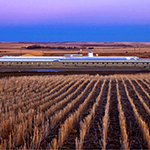One of the world’s most innovative companies is operating from a campus with buildings dating back to 1943. Though this sounds absurd, it’s completely factual, and Michael Wright is on a mission to improve the situation. He’s the director of real estate and facilities for SRI International, a company that counts the first Internet transmission, liquid-crystal displays, the speech-recognition technology behind Apple’s Siri, and the invention of the computer mouse by its own Doug Engelbart among its patented accomplishments (not to mention groundbreaking cancer and robotics research and innovations to improve national security).
Over the next
25
years, the SRI campus renovations will result in
30%
more efficient facilities,
13
new buildings, an employee capacity of
3,000
(far surpassing today’s headcount of 1,600), and a 63-acre campus, of which
37%
will be landscaped.
Nearly half of SRI’s 2,500 global employees hold advanced degrees, and most of these workers perform their highly technical research on a 62-acre campus in Menlo Park, California. The large Silicon Valley campus was first built as an army hospital in 1943, and SRI then took up residence there in 1947. Fast-forward 66 years, and SRI has grown by leaps and bounds (nearing $550 million in annual revenue) and invented some of today’s most amazing and life-changing technology, yet it’s still working in the same buildings. “Our current structures go back to 1943,” Wright says. “Every day I sit in an office that is actually that old, knowing that we could achieve far more in terms of energy management, occupant comfort, and research needs with a new building stock.”
At 1.3 million square feet, most, if not all, of SRI’s headquarters would benefit from a facelift, and Wright’s team is seeking approval for 13 new buildings as well—all part of Wright’s 25-year master plan for a full renovation of the campus. He and his colleagues are currently working with the city of Menlo Park to obtain approvals for the complex’s renovation. “We perform oceanic research, bio research, and other very specialized work like artificial intelligence,” he says. “We manage the largest radio telescope in the world and do lots of R&D. We need very specialized facilities.”
Because of its accomplishments, SRI attracts many of the best and brightest scientists and researchers from around the world, but it has competition for those recruits. A new campus would help the company compete with the likes of Google and Facebook, who have state-of-the-art facilities.
SRI’s new master plan features flexible buildings that can adapt and evolve along with the company. Wright says the first new structure will likely be a laboratory, and robust infrastructure and ample load-carrying capacities will ease any necessary modifications. A wetlab and an engineering facility will follow closely soon thereafter.

The facilities team plans to transform the isolated campus’s asphalt maze of sidewalks into a sustainable and united pedestrian area oriented around a central core. The eco-friendly design will encourage workers to take advantage of their Bay Area location and its 11 months of ample sunlight. The project’s architects and engineers are aiming for LEED Silver levels, operable windows and solar orientation will improve occupant comfort, and dining, conference, and fitness areas will address lifestyle needs. “Our employees will be happier, and they’ll be closer to each other in proximity,” Wright says. “Lots of exciting collaboration happens when people from different parts of the organization get together.”
Not surprisingly, given SRI’s line of work, its campus will have a few unusual bells and whistles. One of the company’s strategies is to take its R&D and spin it into innovations applicable in the everyday world. Most notably, the think tank yielded the technology behind Siri, Apple’s natural-language interface that listens to verbal commands and questions and performs actions accordingly. SRI plans to incorporate similar AI controls and other intellectual property into its master plan, and it has already added retina recognition to its security program.
The new campus will also generate significant savings. While SRI has been able to perform well with its old building stock, innovations have been harder and more expensive. “New, sustainable, flexible buildings will increase our speed and allow us to work in a more cost-effective way,” Wright says, noting that energy consumption will be reduced by 30 percent. He and his team also say the new buildings will boast life expectancies of up to 75 years.

Located less than two blocks from a commuter train station, the new campus will continue to fit perfectly with the company’s transit-conscious culture. Today, the organization offers an active transportation-management program, and nearly half of its campus population arrives to work in something other than a single-occupant car.
SRI sent its application to the city of Menlo Park at the onset of the decades-long, multiphase project because the master-plan development agreement will keep Wright and his team from needing to repeat zoning and permitting applications for every single building. “We’re entering into an agreement up front to remove the burden over the next 25 years,” he says. The plan will help the company and the city agree on the number of buildings and their specifications, including height, location, size, color, and materials.
The new campus will better reflect the soul of SRI, and Wright expects it to become an important recruiting tool. “Prospective employees and clients who visit the headquarters should find a facility that tells the story of the company,” he says. “Our new campus will better tell our story.”



